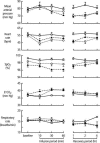Dexmedetomidine: a novel sedative-analgesic agent
- PMID: 16369581
- PMCID: PMC1291306
- DOI: 10.1080/08998280.2001.11927725
Dexmedetomidine: a novel sedative-analgesic agent
Abstract
Since the first report of clonidine, an alpha2-adrenoceptor agonist, the indications for this class of drugs have continued to expand. In December 1999, dexmedetomidine was approved as the most recent agent in this group and was introduced into clinical practice as a short-term sedative (<24 hours). Alpha2-adrenoceptor agonists have several beneficial actions during the perioperative period. They decrease sympathetic tone, with attenuation of the neuroendocrine and hemodynamic responses to anesthesia and surgery; reduce anesthetic and opioid requirements; and cause sedation and analgesia. They allow psychomotoric function to be preserved while letting the patient rest comfortably. With this combination of effects, alpha2-adrenoceptor agonists may offer benefits in the prophylaxis and adjuvant treatment of perioperative myocardial ischemia. Furthermore, their role in pain management and regional anesthesia is expanding. Side effects consist of mild to moderate cardiovascular depression, with slight decreases in blood pressure and heart rate. The development of new, more selective alpha2-adrenoceptor agonists with improved side effect profiles may provide a new concept for the administration of perioperative anesthesia and analgesia. This review aims to give background information to improve understanding of the properties and applications of the novel alpha2-adrenoceptor agonist, dexmedetomidine.
Figures





References
-
- Tamsen A, Gordh T. Epidural clonidine produces analgesia. Lancet. 1984;2:231–232. - PubMed
-
- Clarke KW, Hall LW. “Xylazine”—a new sedative for horses and cattle. Vet Rec. 1969;85:512–517. - PubMed
-
- Alquist RP. A study of adrenergic receptors. Am J Physiol. 1948;153:586–589. - PubMed
-
- Langer SZ. Presynaptic regulation of catecholamine release. Biochem Pharmacol. 1974;23:1793–1800. - PubMed
LinkOut - more resources
Full Text Sources
Other Literature Sources
Medical
